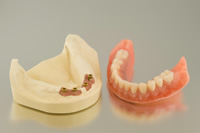General Dentistry
Bridges
 Dental bridges are natural-looking tooth replacements that help maintain facial structure, reduce stress on the jaw and fill in the gaps caused by missing teeth. Bridges are cemented to the existing teeth and do not come out.
Dental bridges are natural-looking tooth replacements that help maintain facial structure, reduce stress on the jaw and fill in the gaps caused by missing teeth. Bridges are cemented to the existing teeth and do not come out.
A dental bridge can be used to:
- Restore smile
- Reduce the risk of gum disease
- Restore the ability to bite and chew
- Improve speech
- Prevent remaining teeth from drifting out of position
Types of Dental Bridges
There are three main types of bridges:
Traditional bridges - Also known as fixed bridges, traditional bridges are used to replace one or more missing teeth. The procedure involves creating a crown for the tooth or implant on either side of the missing tooth, with a pontic, or a false tooth, in between. Unlike dentures, fixed bridges cannot be taken out of the mouth. These are the most common type of dental bridge and are made either of porcelain fused to metal or of ceramics.
Resin bonded bridges - Also known as Maryland bonded bridges, resin bonded bridges are primarily used for the front teeth. They are less expensive than fixed bridges and are best when the teeth are healthy and do not have any large fillings. A false tooth is fused with resin to metal bands that are bonded to the adjacent teeth and hidden from view. Resin bonded bridges require minimal preparation of the adjacent teeth.
Cantilever bridges - These bridges are used in areas of the mouth that are under low amounts of stress, such as the back teeth. Cantilever bridges are recommended when there are teeth on only one side of the open space.
Dental Bridge Procedure
There are several steps that are taken in order to create a bridge:
First step - The adjacent teeth must be prepared. This involves removing some of the enamel to allow room for the crown to be placed over them.
Second step - Impressions of the teeth are made. These will be sent to a laboratory so a bridge, pontic and crowns can be created to uniquely fit the patient's mouth. This may take two to three weeks. While the bridge is being made, the patient will be given a temporary dental bridge to protect the exposed teeth and gums.
On the next dental visit, the temporary bridge will be removed and replaced with the new, permanent bridge. The doctor will make sure the bridge fits properly and then cement it to the teeth.
Dentures
 Dentures are prosthetic devices designed to help patients with missing teeth, perform daily activities that would otherwise be difficult. Patients who have lost their natural teeth due to decay, periodontal disease or injury may suffer from further decay, and difficulty eating and speaking. The absence of teeth can also lead to a sunken, collapsed appearance in the mouth area. By restoring the physical presence of teeth, this malformation is corrected and the patient can maintain their normal appearance.
Dentures are prosthetic devices designed to help patients with missing teeth, perform daily activities that would otherwise be difficult. Patients who have lost their natural teeth due to decay, periodontal disease or injury may suffer from further decay, and difficulty eating and speaking. The absence of teeth can also lead to a sunken, collapsed appearance in the mouth area. By restoring the physical presence of teeth, this malformation is corrected and the patient can maintain their normal appearance.
Types of Dentures
There are three types of dentures:
- Full, or complete dentures
- Fixed partial dentures
- Removable partial dentures
Most patients only require partial dentures, if they are only missing a few teeth. Additionally, most partial dentures are fixed in place by the crown-and-bridge technique. In some cases, the fixed version is not possible for patients due to complicating factors.
When considering having dentures made, a denturist or prosthodontist is generally recommended over a dentist, with the exception of those dentists who are exceptionally experienced and detailed. Maxillary, or top teeth dentures tend to achieve better unification with the toothless gums due to the improvement in suction from the smooth surface. Mandibular, or bottom teeth dentures are much more effective if the patient still retains some natural teeth.
For more information about General Dentistry or to schedule an appointment, feel free to fill out our convenient contact form or call us directly at 212-935-9300.

